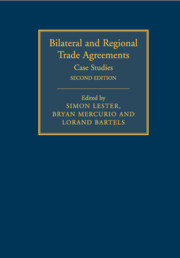Book contents
- Frontmatter
- Contents
- Contributors
- Table of cases
- Table of treaties and international agreements
- List of abbreviations
- 1 The United States–Korea Free Trade Agreement
- 2 EU–Korea Free Trade Agreement
- 3 United States–Colombia Trade Promotion Agreement
- 4 China–New Zealand Free Trade Agreement
- 5 China–Taiwan Free Trade Agreement
- 6 The ASEAN–Australia–New Zealand FTA (AANZFTA)
- 7 The CARIFORUM–EU Economic Partnership Agreement
- Index
7 - The CARIFORUM–EU Economic Partnership Agreement
Published online by Cambridge University Press: 05 December 2015
- Frontmatter
- Contents
- Contributors
- Table of cases
- Table of treaties and international agreements
- List of abbreviations
- 1 The United States–Korea Free Trade Agreement
- 2 EU–Korea Free Trade Agreement
- 3 United States–Colombia Trade Promotion Agreement
- 4 China–New Zealand Free Trade Agreement
- 5 China–Taiwan Free Trade Agreement
- 6 The ASEAN–Australia–New Zealand FTA (AANZFTA)
- 7 The CARIFORUM–EU Economic Partnership Agreement
- Index
Summary
Introduction
The Economic Partnership Agreement (EPA), concluded in 2008 between the European Community (EC), its Member States and the CARIFORUM States, ushered in a new trading relationship between the two regions. The Cotonou Agreement signed between the EC and its Member States and the African, Caribbean and Pacific (ACP) Group of States in 2000 had signalled the transformation of the trade and development relationship between the ACP and EC. Since 1975, the Lomé trade regime between Europe and the ACP States had been marked by non-reciprocal preferential access for ACP products into the EC market. This trading arrangement was revisited not only because it had not generated meaningful growth and diversification of ACP exports to Europe but also because two dispute settlement panels had found it to be in breach of the General Agreement on Tariffs and Trade (GATT).
With a view to achieving the gradual integration of ACP States into the world economy, the Cotonou Agreement called for new WTO-compatible trading arrangements that progressively removed barriers to trade and enhanced cooperation in all areas related to trade. The Cotonou trade preferences were maintained for ACP countries until 31 December 2007, by which time the new trading arrangements called EPAs were to be negotiated. The waiver granted by the WTO in 2001 for the Cotonou Agreement's preferential trade regime also expired at the end of that period.
The CARIFORUM–EU EPA (CEPA) is the first and, to date, the only comprehensive EPA to be concluded by the ACP States. Given that Haiti is the only CARIFORUM least-developed country (LDC), the other CARIFORUM countries would not have enjoyed duty-free quota free access under the EU's Everything But Arms (EBA) initiative. Therefore, if an EPA were not in place by 1 January 2008, the CARIFORUM non-LDCs would have had to conduct trade in goods on the basis of the EU's Generalized System of Preferences (GSP). The GSP was less advantageous because it does not cover important exports such as sugar, bananas, brown rice and alumina, it includes a graduation mechanism and, by virtue of the requirements of the WTO Enabling Clause, it could not extend special preferences to CARIFORUM non-LDCs. Unlike other ACP States, the CARIFORUM States chose not to pursue the option of negotiating an interim EPA governing only market access in goods.
- Type
- Chapter
- Information
- Bilateral and Regional Trade AgreementsCase Studies, pp. 133 - 160Publisher: Cambridge University PressPrint publication year: 2016
- 2
- Cited by

